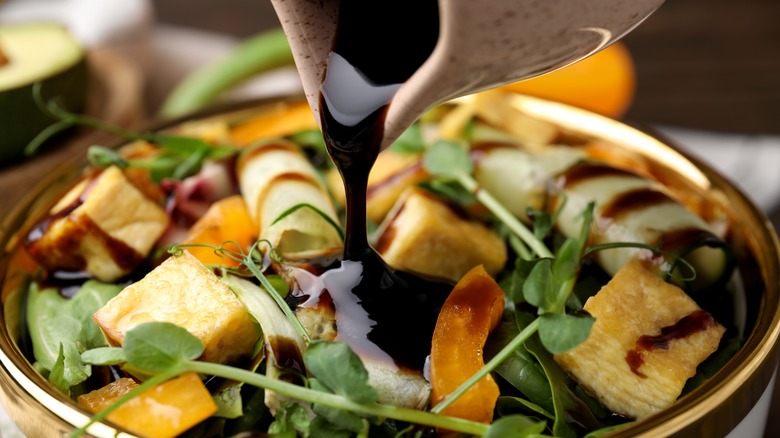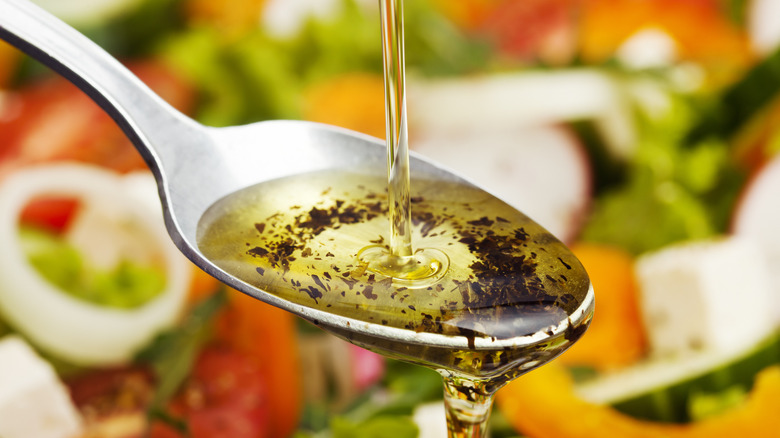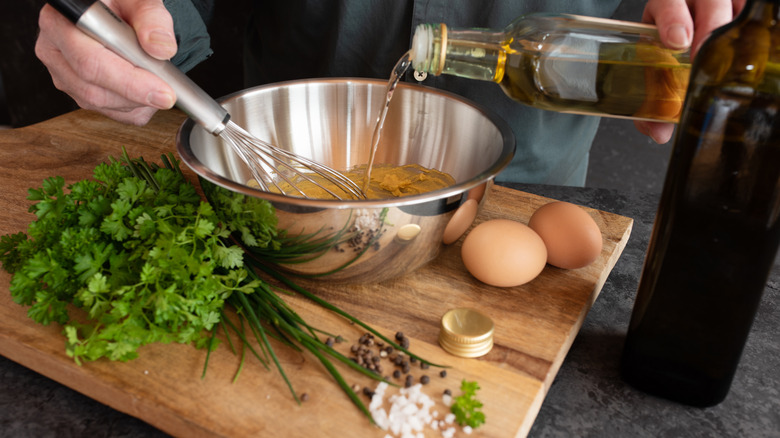When Adding Oil And Vinegar To Salad, Order Matters
From a drizzle of sesame ginger sauce to the perfect homemade Caesar, a salad dressing can easily make or break a bowl of fresh greens. Many believe it's hard to go wrong with the classic combination of oil and vinegar. This iconic choice is the perfect balance of rich, smooth textures and vibrant, tangy flavor, so it's no wonder it's become such a fan favorite over the years.
If you're not mixing up a batch of oil-and-vinegar dressing in bulk and are ready to chow down on a salad immediately, you can save time by mixing the oil and vinegar directly in your salad. This helps you avoid the hassle of cleaning any unnecessary dishes too, so why not? Still, the order matters when adding oil and vinegar to a bowl of salad ingredients, and doing so incorrectly can lead to soggy, wilted greens. To keep your salad crisp and vibrant, add the vinegar to the greens before you add the oil. Although it may seem like an odd or silly rule, adding oil to your salad first could cause unexpected repercussions.
Why you need to save that oil for last
The reason it's beneficial to add the vinegar to your salad before adding the oil has to do with the lettuce itself. Lettuce leaves have a tough, waxy exterior that keeps liquids from penetrating the leaves' surface and making them wilt. Oil, however, can easily sneak past this protective outer layer and cause the leaf to break down. When mixing up an oil and vinegar dressing directly in a salad, adding vinegar first creates a barrier between the lettuce and oil, ensuring the lettuce retains its crisp, fresh texture for a longer period.
Oil's innate density doesn't just leave lettuce leaves vulnerable to wilting, but also all of the other ingredients in the bowl. Another reason to avoid adding this rich, heavy ingredient first is that it will coat all your salad's ingredients and prevent the vinegar from sticking to the salad veggies. This will create a lackluster salad with only one component of the dressing adhering to the ingredients in your salad, with the vinegar left to pool at the bottom of your bowl.
Another way to protect your delicate salad greens and the overall flavors in your salad is to use a third element in your dressing: An emulsifier. But this means you're gonna dirty another bowl.
The important role of emulsifiers in oil and vinegar dressing
If you're mixing up your oil and vinegar in a separate bowl before you dress your salad with it, you can use an emulsifier to help the oil and vinegar play nicer with the salad ingredients and also with each other.
There is scientific support for using an emulsifier to avoid a sad, soggy salad. Oil and vinegar do not mix well on their own because their molecules do not bind together. So, to make them meld, you need to add a third element to the dressing that both vinegar and oil will bond to. This can be anything from egg yolks to mayonnaise, whatever foodstuff has the right molecular makeup for both oil and vinegar to stick to. Some recipes for a basic vinaigrette use Dijon mustard.
Oil and vinegar is a simplistic salad dressings, yes, but there's a very delicate balance to this mixture, too. Paying attention to how you make it will go along way to avoiding a soggy, wilty salad.


